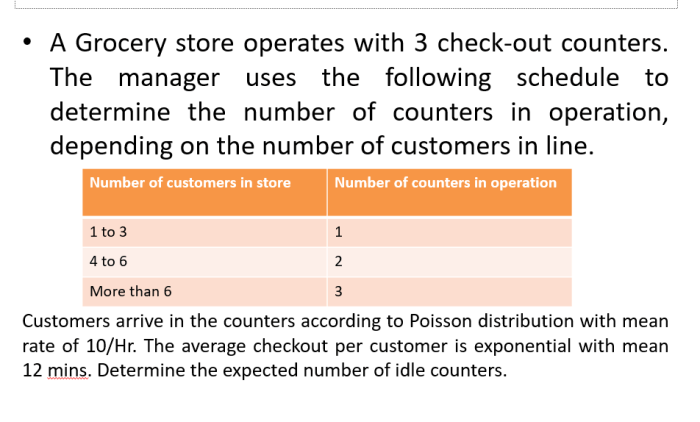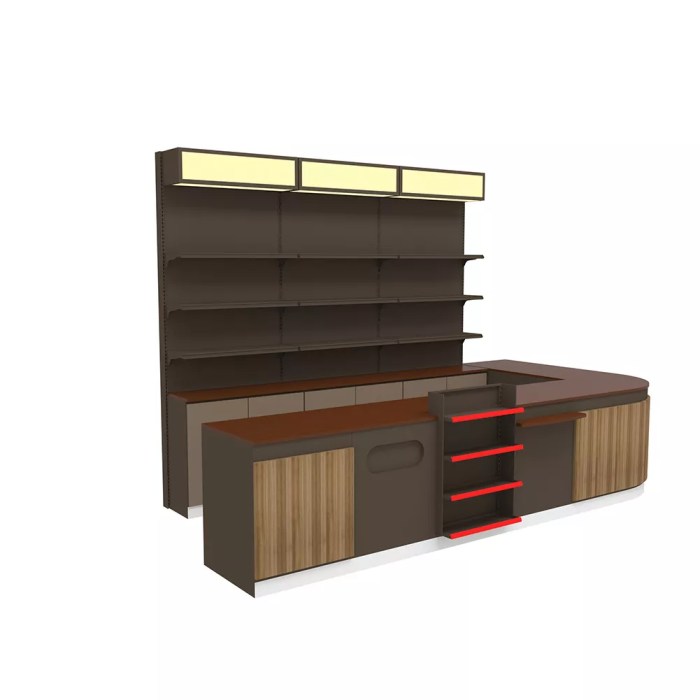Grocery store point of sale software – Grocery store point of sale (POS) software has revolutionized the retail grocery landscape. Modern POS systems offer far more than just processing transactions; they provide comprehensive inventory management, customer relationship management (CRM) tools, and valuable sales data analysis, all contributing to increased efficiency and profitability for grocery stores of all sizes. This allows for better stock control, targeted marketing campaigns, and ultimately, a smoother shopping experience for customers.
The integration of features like loyalty programs, mobile payment options, and even self-checkout kiosks further enhances the customer journey while simplifying operations for store staff. Sophisticated reporting capabilities provide insights into sales trends, helping grocers optimize pricing strategies and product placement. The overall impact is a more streamlined, data-driven approach to running a successful grocery business.

Source: cheggcdn.com
In today’s competitive grocery landscape, efficiency and accuracy are paramount. A robust Point of Sale (POS) system is no longer a luxury but a necessity for grocery stores of all sizes, from small independent shops to large supermarket chains. This comprehensive guide delves into the intricacies of grocery store POS software, exploring its features, benefits, selection process, and future trends.
We’ll cover everything from basic functionalities to advanced analytics, ensuring you have a clear understanding of how the right POS system can significantly impact your business’s bottom line.
Understanding the Core Features of Grocery POS Software
A modern grocery POS system goes far beyond simply processing transactions. It’s a multifaceted tool designed to streamline operations and enhance customer experience. Key features include:
Transaction Processing: The Foundation
- Fast and Accurate Checkout: Efficient barcode scanning, quick payment processing (credit/debit cards, mobile payments, loyalty programs), and minimizing errors are crucial.
- Inventory Management Integration: Real-time updates on stock levels, low-stock alerts, and automated ordering capabilities are essential for preventing stockouts and optimizing inventory.
- Multiple Payment Options: Supporting various payment methods, including EMV chip cards, contactless payments (Apple Pay, Google Pay), and gift cards, is vital for customer convenience.
- Receipt Printing and Emailing: Generating clear and detailed receipts, with options for email delivery, improves customer satisfaction and reduces paper waste.
Advanced Features for Enhanced Efficiency, Grocery store point of sale software
- Employee Management: Tracking employee hours, managing permissions, and generating payroll reports simplify HR processes.
- Customer Relationship Management (CRM): Collecting customer data, creating loyalty programs, and personalizing marketing efforts enhance customer retention.
- Reporting and Analytics: Generating detailed sales reports, inventory reports, and customer behavior analytics provides valuable insights for informed decision-making. This includes features like sales trend analysis, best-selling items, and slow-moving inventory identification.
- Integration with Other Systems: Seamless integration with accounting software, inventory management systems, and e-commerce platforms streamlines operations and improves data consistency.
- Scalability and Flexibility: The system should be able to adapt to your business’s growth, handling increasing transaction volumes and expanding functionalities.
- Loss Prevention Tools: Features like employee tracking, inventory monitoring, and fraud detection can significantly reduce shrinkage.
- Self-Checkout Kiosks: Offering self-checkout options improves customer flow and reduces wait times, particularly during peak hours. This often integrates directly with the main POS system.
Choosing the Right Grocery POS Software: A Step-by-Step Guide
Selecting the ideal POS system requires careful consideration of several factors:
1. Define Your Needs and Budget
Assess your business’s specific requirements. Consider the size of your store, transaction volume, payment methods accepted, and desired functionalities. Establish a realistic budget that accommodates the software cost, hardware requirements, and implementation expenses.
2. Research and Compare Different POS Providers
Explore various POS providers, comparing their features, pricing models (subscription-based, one-time purchase), and customer support. Read reviews and testimonials from other grocery stores to gauge their experiences.
3. Consider Cloud-Based vs. On-Premise Solutions
Cloud-based systems offer accessibility from anywhere, automatic updates, and reduced IT infrastructure costs. On-premise systems provide greater control over data security but require dedicated hardware and IT expertise.

Source: leadongcdn.com
4. Evaluate Integration Capabilities
Ensure the POS system integrates seamlessly with your existing accounting software, inventory management system, and other relevant applications. This minimizes data entry and improves operational efficiency.
5. Test the Software Before Implementation
Request a demo or trial period to test the software’s functionality and usability. Ensure it meets your specific needs and that your employees can easily use it.
6. Choose a Reputable Provider with Excellent Customer Support
Select a provider with a proven track record, reliable customer support, and comprehensive training resources. Ongoing support is crucial for resolving technical issues and maximizing the system’s benefits.
The Future of Grocery Store POS Systems
The grocery retail landscape is constantly evolving, and POS systems are adapting to meet the changing demands. Future trends include:
- Increased Automation: Further automation of tasks such as inventory management, ordering, and price adjustments will enhance efficiency.
- Enhanced Analytics and AI: Artificial intelligence (AI) will play a larger role in analyzing sales data, predicting customer behavior, and optimizing pricing strategies.
- Improved Mobile Integration: Mobile POS systems will become more prevalent, enabling cashiers to process transactions anywhere in the store.
- Blockchain Technology: Blockchain technology could enhance supply chain transparency and improve food safety tracking.
- Integration with Smart Shelves and IoT Devices: Connecting POS systems with smart shelves and other IoT devices will provide real-time inventory data and improve stock management.
Frequently Asked Questions (FAQ)
- Q: How much does grocery POS software cost? A: The cost varies significantly depending on the features, provider, and whether it’s a cloud-based or on-premise solution. Expect to pay anywhere from a few hundred dollars per month to several thousand dollars for a comprehensive system.
- Q: What are the benefits of using grocery POS software? A: Benefits include increased efficiency, improved accuracy, better inventory management, enhanced customer service, and valuable data-driven insights.
- Q: How long does it take to implement a grocery POS system? A: Implementation time varies depending on the system’s complexity and the size of your store. It can range from a few weeks to several months.
- Q: What type of hardware is needed for a grocery POS system? A: You’ll typically need POS terminals, barcode scanners, receipt printers, and potentially other peripherals like cash drawers and credit card readers.
- Q: What kind of training is required for employees? A: Most providers offer training programs to help your employees learn how to use the POS system effectively.
- Q: How can I choose the best POS system for my grocery store? A: Carefully assess your needs, compare different providers, test the software, and consider factors like cost, features, and customer support.
Conclusion
Investing in the right grocery store POS software is a strategic decision that can significantly impact your business’s success. By understanding the key features, carefully evaluating your options, and staying informed about future trends, you can select a system that optimizes efficiency, enhances customer experience, and drives profitability.
Call to Action: Grocery Store Point Of Sale Software
Ready to upgrade your grocery store’s operations? Contact us today for a free consultation and let us help you find the perfect POS solution for your business!
In conclusion, the implementation of robust grocery store POS software presents a significant opportunity for growth and efficiency. By leveraging the advanced features available in modern systems, grocery stores can improve their operational effectiveness, enhance customer satisfaction, and gain a competitive edge in today’s dynamic market. The data-driven insights provided allow for informed decision-making, leading to better inventory management, targeted marketing, and ultimately, increased profitability.
The future of grocery retail is undeniably intertwined with the ongoing development and adoption of sophisticated POS technology.
Quick FAQs
What are the key features to look for in grocery store POS software?
Key features include inventory management, sales reporting, customer relationship management (CRM), payment processing integration, employee management, and loyalty program capabilities.
How much does grocery store POS software typically cost?
Pricing varies greatly depending on the features, scalability, and vendor. Expect costs ranging from monthly subscription fees to one-time purchases with ongoing support contracts. It’s best to obtain quotes from several vendors.
Is cloud-based POS software better than on-premise systems?
Cloud-based systems offer greater flexibility, accessibility, and automatic updates. On-premise systems provide more control but require dedicated IT infrastructure and maintenance.
How can I integrate my POS system with other business tools?
Many POS systems offer API integrations with accounting software, inventory management platforms, and e-commerce solutions. Check vendor specifications for compatibility.
